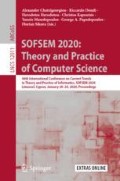Abstract
This paper considers a game in which a single cop and a single robber take turns moving along the edges of a given graph G. If there exists a strategy for the cop which enables it to be positioned at the same vertex as the robber eventually, then G is called cop-win, and robber-win otherwise. In contrast to previous work, we study this classical combinatorial game on edge-periodic graphs. These are graphs with an infinite lifetime comprised of discrete time steps such that each edge e is assigned a bit pattern of length \(l_e\), with a 1 in the i-th position of the pattern indicating the presence of edge e in the i-th step of each consecutive block of \(l_e\) steps. Utilising the known framework of reachability games, we obtain an \(O(\textsf {LCM}(L)\cdot n^3)\) time algorithm to decide if a given n-vertex edge-periodic graph \(G^\tau \) is cop-win or robber-win as well as compute a strategy for the winning player (here, L is the set of all edge pattern lengths \(l_e\), and \(\textsf {LCM}(L)\) denotes the least common multiple of the set L). For the special case of edge-periodic cycles, we prove an upper bound of \(2\cdot l \cdot \textsf {LCM}(L)\) on the minimum length required of any edge-periodic cycle to ensure that it is robber-win, where \(l = 1\) if \(\textsf {LCM}(L) \ge 2\cdot \max L \), and \(l=2\) otherwise. Furthermore, we provide constructions of edge-periodic cycles that are cop-win and have length \(1.5 \cdot \textsf {LCM}(L)\) in the \(l=1\) case and length \(3\cdot \textsf {LCM}(L)\) in the \(l=2\) case.
Access this chapter
Tax calculation will be finalised at checkout
Purchases are for personal use only
References
Aigner, M., Fromme, M.: A game of cops and robbers. Discret. Appl. Math. 8(1), 1–12 (1984). https://doi.org/10.1016/0166-218X(84)90073-8
Berarducci, A., Intrigila, B.: On the cop number of a graph. Adv. Appl. Math. 14(4), 389–403 (1993). https://doi.org/10.1006/aama.1993.1019
Berwanger, D.: Graph games with perfect information. arXiv:1407.1647 (2013)
Bonato, A., MacGillivray, G.: A general framework for discrete-time pursuit games (2015). Unpublished manuscript
Bonato, A., Nowakowski, R.: The Game of Cops and Robbers on Graphs, Student Mathematical Library, vol. 61. American Mathematical Society, Providence (2011). https://doi.org/10.1090/stml/061
Casteigts, A.: A Journey Through Dynamic Networks (with Excursions). Habilitation à diriger des recherches, University of Bordeaux, June 2018. https://tel.archives-ouvertes.fr/tel-01883384
Casteigts, A., Flocchini, P., Quattrociocchi, W., Santoro, N.: Time-varying graphs and dynamic networks. In: Frey, H., Li, X., Ruehrup, S. (eds.) ADHOC-NOW 2011. LNCS, vol. 6811, pp. 346–359. Springer, Heidelberg (2011). https://doi.org/10.1007/978-3-642-22450-8_27
Chung, T.H., Hollinger, G.A., Isler, V.: Search and pursuit-evasion in mobile robotics. Auton. Robot. 31(4), 299–316 (2011). https://doi.org/10.1007/s10514-011-9241-4
Grädel, E., Thomas, W., Wilke, T. (eds.): Automata Logics, and Infinite Games: A Guide to Current Research. Springer, New York (2002). https://doi.org/10.1007/3-540-36387-4
Hahn, G., MacGillivray, G.: A note on k-cop, l-robber games on graphs. Discret. Math. 306(19), 2492–2497 (2006). https://doi.org/10.1016/j.disc.2005.12.038. Creation and Recreation: A Tribute to the Memory of Claude Berge
Kehagias, A., Konstantinidis, G.: Cops and robbers, game theory and Zermelo’s early results. arXiv:1407.1647 (2014)
Kehagias, A., Mitsche, D., Pralat, P.: The role of visibility in pursuit/evasion games. Robotics 4, 371–399 (2014)
Michail, O.: An introduction to temporal graphs: an algorithmic perspective. Internet Math. 12(4), 239–280 (2016). https://doi.org/10.1080/15427951.2016.1177801
Michail, O., Spirakis, P.G.: Elements of the theory of dynamic networks. Commun. ACM 61(2), 72–72 (2018). https://doi.org/10.1145/3156693
Nowakowski, R., Winkler, P.: Vertex-to-vertex pursuit in a graph. Discret. Math. 43(2), 235–239 (1983). https://doi.org/10.1016/0012-365X(83)90160-7
Parsons, T.D.: Pursuit-evasion in a graph. In: Alavi, Y., Lick, D.R. (eds.) Theory and Applications of Graphs, pp. 426–441. Springer, Heidelberg (1978). https://doi.org/10.1007/BFb0070400
Patsko, V., Kumkov, S., Turova, V.: Pursuit-evasion games. In: Basar, T., Zaccour, G. (eds.) Handbook of Dynamic Game Theory, pp. 1–87. Springer, Heidelberg (2017). https://doi.org/10.1007/978-3-319-27335-8-30-1
Quilliot, A.: Jeux et pointes fixes sur les graphes. Ph.D. thesis, University of Paris VI (1978)
Rankin, B.A.: Ramanujan: Twelve lectures on subjects suggested by his life and work. Math. Gaz. 45(352), 166 (1961). https://doi.org/10.1017/S0025557200044892
Seymour, P., Thomas, R.: Graph searching and a min-max theorem for tree-width. J. Comb. Theory Ser. B 58(1), 22–33 (1993). https://doi.org/10.1006/jctb.1993.1027
Acknowledgements
The authors would like to thank Maciej Gazda for helpful discussions regarding reachability games, as well as an anonymous reviewer for a suggestion leading to the running-time for the variant with k cops mentioned at the end of Sect. 3.
Author information
Authors and Affiliations
Corresponding author
Editor information
Editors and Affiliations
Rights and permissions
Copyright information
© 2020 Springer Nature Switzerland AG
About this paper
Cite this paper
Erlebach, T., Spooner, J.T. (2020). A Game of Cops and Robbers on Graphs with Periodic Edge-Connectivity. In: Chatzigeorgiou, A., et al. SOFSEM 2020: Theory and Practice of Computer Science. SOFSEM 2020. Lecture Notes in Computer Science(), vol 12011. Springer, Cham. https://doi.org/10.1007/978-3-030-38919-2_6
Download citation
DOI: https://doi.org/10.1007/978-3-030-38919-2_6
Published:
Publisher Name: Springer, Cham
Print ISBN: 978-3-030-38918-5
Online ISBN: 978-3-030-38919-2
eBook Packages: Computer ScienceComputer Science (R0)

